Give me the Dnieper! 80 years ago the battle for the Dnieper ended
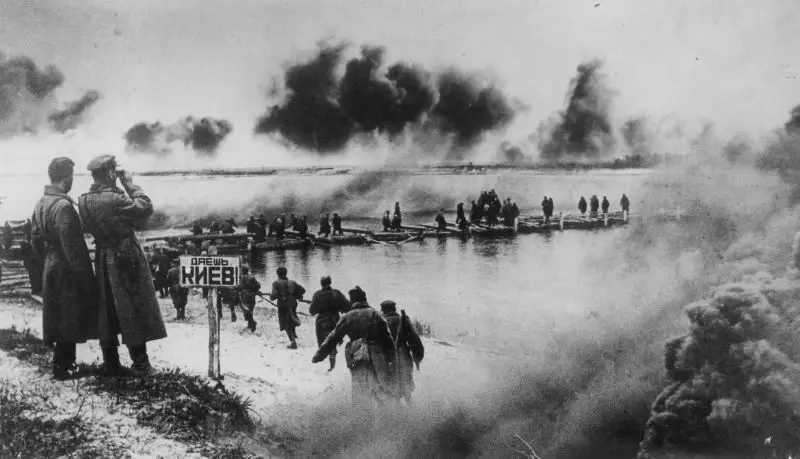
80 years ago the battle for the Dnieper ended. The Red Army liberated the Left Bank, crossed the Dnieper, seizing strategic bridgeheads on the Right Bank and recapturing Kyiv.
The Battle of the Dnieper entered into history as one of the largest and most successfully carried out operations of the Red Army to liberate the occupied territory of the Ukrainian SSR. About 4 million people took part in this battle, and the front line was stretched to 2 thousand kilometers. In 4 months, Soviet troops liberated 160 cities and 38 thousand settlements.
General situation
The defeat of the Wehrmacht at the Kursk Bulge led to a radical change in the situation at the front. The Red Army firmly seizes the strategic initiative. The enemy front in the Oryol and Kharkov directions was broken through.
The German Armed Forces suffered heavy losses and were no longer able to conduct strategic offensive operations. At the same time, the German army retained a high combat potential and was still a strong and skilled enemy. The Germans had a qualitative advantage from commanders of all levels, starting from squad and platoon commanders.
German divisions maintained better maneuverability, skillfully and timely transferring formations to threatened areas. The sparse network of Russian roads made it possible to take advantage of air reconnaissance and promptly learn about the transfer of enemy troops. Plus radio intelligence and military intelligence. The quality of the Wehrmacht made it possible to avoid boilers and catastrophic defeats.
The German High Command goes on the defensive, trying to hold the front and retain occupied areas rich in resources. It was necessary to gain time to stabilize the situation on the Russian front, to prepare and strengthen reserves.
– Field Marshal Keitel noted in his report to the OKW (Wehrmacht High Command).
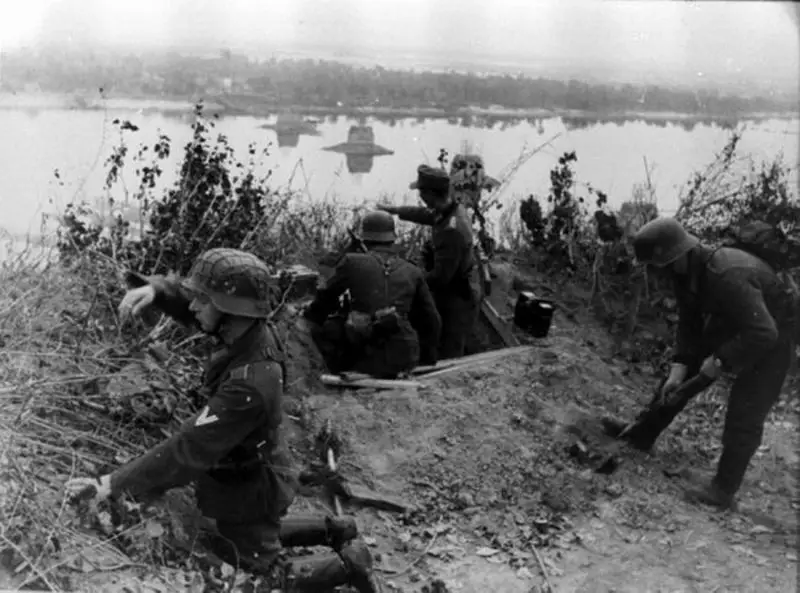
A German MG machine gun crew is preparing a firing position on the banks of the Dnieper
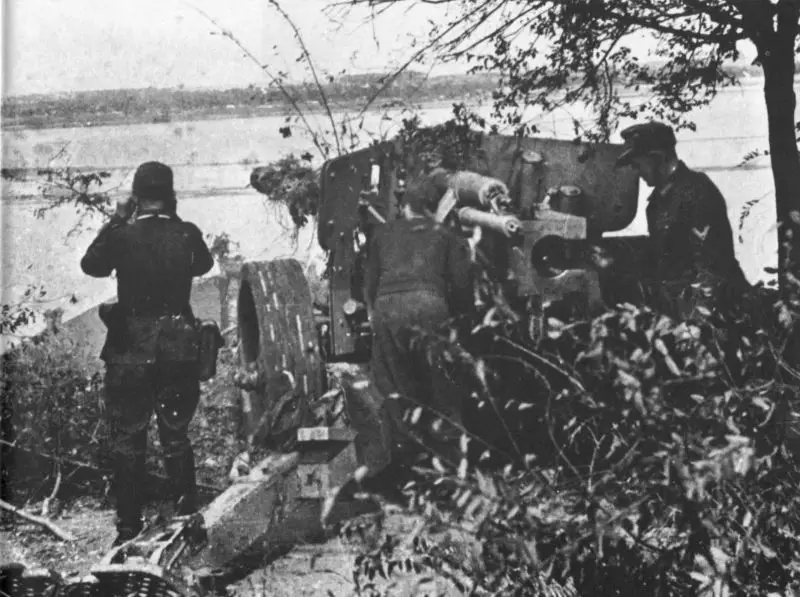
German 88-mm anti-tank gun PaK 43, installed in a position on the banks of the Dnieper. September 1943
On August 11, 1943, Hitler gave the order to build a strategic defensive line along the Molochnaya River, the middle reaches of the Dnieper and then north along the Sozh River, through Orsha, Vitebsk, Pskov and further along the Narva River. The “Eastern Wall” was created, which German propaganda declared impregnable. Its main part was the Dnieper line.
At the line from Sevsk to the Sea of Azov, the 2nd German Army of Army Group Center, the 4th tank, 8th, 1st Tank and 6th Armies of the South Group. In total more than 1,2 million people; 12,6 thousand guns and mortars, about 2 tanks and self-propelled guns, up to 100 thousand aircraft.
The Soviet Headquarters, guided by the plan for the summer-autumn campaign of 1943 and using the success at the Kursk Bulge, decided to develop and expand the offensive. The Central, Voronezh, Steppe, Southwestern and Southern Fronts were tasked with defeating the main enemy forces on the southern wing of the Soviet-German front, liberating Donbass, Crimea, the entire Left Bank of the Dnieper, and crossing the Dnieper.

Liberation of the Left Bank
Fight for Donbass (Our Donbass!) began during the Battle of Kursk. By the Headquarters directive of August 6, 1943, the Southwestern and Southern Fronts were tasked with defeating the enemy’s Donbass group (1st Tank and the newly formed 6th Field Army from Army Group “South”). The Donbass region was covered by pre-prepared defensive lines. The front line of defense of the German army ran along the Seversky Donets and Mius rivers; in the depths, the defense lines ran along the Krynka, Kalmius and Samara rivers. The Germans had a Mius Front that had been in the making for a long time.
On August 13, Malinovsky's Southwestern Front (SWF) launched an offensive on its right wing. Having crossed the Seversky Donets, the troops of the 46th and 1st Guards Armies of Glagolev and Kuznetsov, after stubborn fighting on the night of August 18, captured the city of Zmiev and established contact with the Steppe Front, assisting in the liberation of Kharkov. On August 16, the main forces of the Southwestern Front went on the offensive - the 6th, 12th and 8th Guards Armies of Shlemin, Danilov and Chuikov. Soviet troops delivered the main blow south of Izyum in the direction of Barvenkovo and Pavlograd. However, it was not possible to break through the strong German defenses on the move. On August 19, a second attack began, but it was also unsuccessful. The Germans brought up reinforcements Aviation.
Tolbukhin's Southern Front (SF) troops went on the offensive on August 18. The 5th Shock and 2nd Guards Armies of Tsvetaev and Zakharov tried to break through the powerful enemy defensive line on the Mius River. After powerful artillery and air preparation, the enemy front was broken through. The 4th Guards Mechanized Corps of Tanaschishin was introduced into the breakthrough, which was advancing to the Amvrosievka - Stalino (Donetsk) area. Part of the SF forces advanced on the coast of the Sea of Azov and liberated Taganrog on August 30.
The sharp deterioration of the situation on the front of the South group caused alarm at German Headquarters. At the end of August, Hitler arrived in Vinnitsa. The Commander-in-Chief of Army Group South, Manstein, asked for new formations, at least 12 divisions, or Donbass must be abandoned, reducing the front line and tightening defensive formations. The Fuhrer promised reinforcements from the fronts of Army Groups Center and North, but it was not possible to remove divisions from the central and northern fronts. The Red Army attacked Army Group Center and was forced to retreat to the west. Group "North" was also unable to allocate a single division.
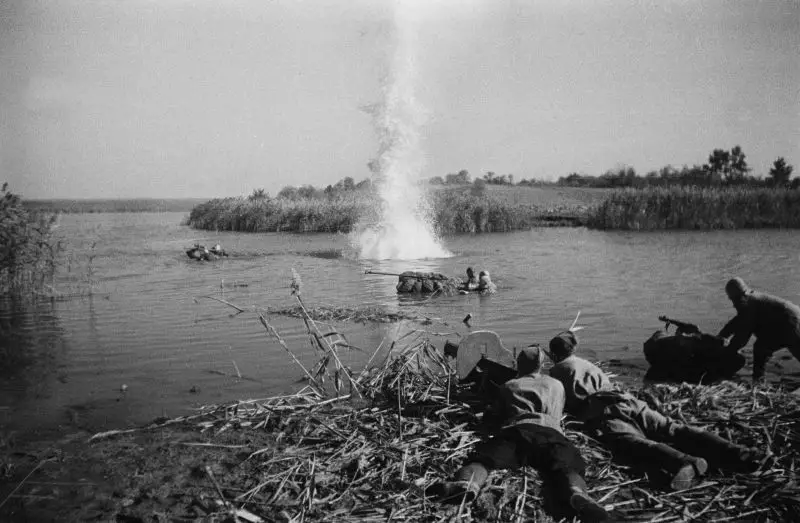
Crossing the Dnieper River by Soviet soldiers using improvised means
Developing the offensive, the troops of the Southern Front liberated Gorlovka and the center of Donbass Stalino, and on September 10, the 44th Army occupied Mariupol (Zhdanov). On the Southwestern Front, after regrouping, it continued the offensive and liberated Proletarsk, Kamyshevakha, Pervomaisk, Artyomovsk and Barvenkovo. The troops of the Southern Fleet and Southwestern Front continued to march west and from September 14 to 20 liberated Gulyai-Polye, Kuibyshevo, Pologi and Pavlograd.
The German army retreated to the Dnieper and further north under the attacks of the troops of the Central, Voronezh and Steppe fronts. The central front went on the offensive on August 26, delivering the main blow to Sevsk and Novgorod-Seversky. The Germans put up stubborn resistance. The offensive developed most successfully south of Sevsk, where Chernyakhovsky’s 60th Army and Rudchenko’s 9th Tank Corps broke through into the northern regions of Ukraine. Part of the forces of the right wing of the front was transferred here, and Soviet troops developed an offensive against Nezhin. The advance of the troops of the Voronezh and Steppe Front developed slowly. However, the right wing of the Voronezh Front liberated Sumy on September 2 and advanced to Romny.
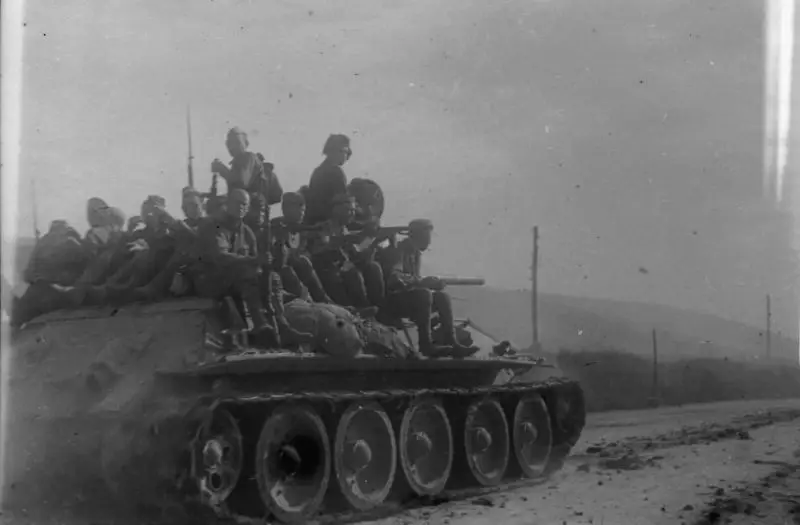
A Soviet T-34 tank with troops moves along the road during the offensive towards the Dnieper. Steppe Front
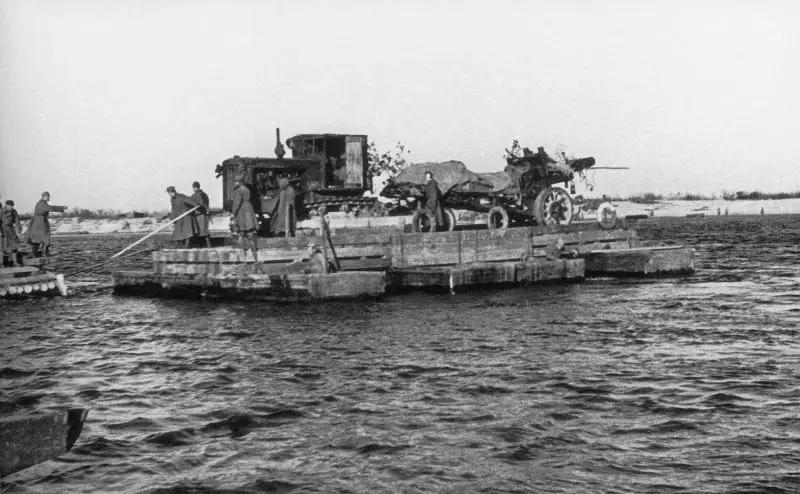
Crossing the Soviet tractor S-65 "Stalinets" with a 152-mm howitzer-cannon of the 1937 model (ML-20) across the Dnieper by ferry. 1943
Breakthrough of the Dnieper line
The headquarters attached key importance to the battle for the Dnieper, strengthening the fronts of the southern wing at the expense of reserves and demanding an early breakthrough to the Dnieper, crossing the great river on the move and capturing bridgeheads. The main efforts of the Central and Voronezh Fronts (from October 20 - the Belorussian and 1st Ukrainian Fronts) were concentrated on the Kiev, and the Steppe Front (2nd Ukrainian) - on the Poltava-Kremenchug directions. The Southwestern Front (3rd Ukrainian) developed an offensive in the Dnepropetrovsk and Zaporozhye directions, and the troops of the Southern Front (4th Ukrainian) - in the directions: Tavria, Crimea and the lower reaches of the Dnieper.
In mid-September 1943, the German command began a general retreat from the Left Bank and Donbass. The Germans used scorched earth tactics, destroying populated areas, destroying industrial and transport infrastructure, burning crops and rustling livestock. The local population was also taken into the Third Reich as slave labor. Only the powerful and rapid advance of the Red Army prevented the Nazis from turning Ukraine into a desert. However, the destruction and losses were terrible.
The German Headquarters hoped that it would be able to stabilize the front on the Dnieper line, where large forces were concentrated. That the Russians have exhausted their strength and means during the offensive and will not be able to immediately break through such a powerful water barrier as the Dnieper.
However, the Nazis miscalculated. Soviet troops, pursuing the enemy, crossed the great Russian river on the move. The forward detachments used any available means - boats, rafts, homemade watercraft. With the arrival of engineering units, sappers built pontoon bridges and crossings across the river.
The troops of the Central Front liberated Chernigov on September 21, and on September 22 they reached the Dnieper, crossed it and captured a bridgehead between the Dnieper and Pripyat rivers. Units of General Pukhov's 13th Army crossed the river north of Kyiv. By the end of the month, front troops advanced to the Sozh and Dnieper rivers in the section from Gomel to Yasnogorodka. In the Voronezh Front zone, Rybalko's 3rd Guards Tank Army reached the Dnieper near Pereyaslav.
On the night of September 22, army units crossed the river 80 km southeast of Kyiv, in the Upper Bukrin area, and captured a bridgehead. In the same area, the river was crossed by troops of the 40th and 47th armies. In fierce battles, Soviet troops expanded the Bukrinsky bridgehead to 11 km along the front and 6 km in depth.
At the end of September, Chibisov's 38th Army crossed the Dnieper in the Lyutezh area, north of Kyiv. On September 23, the troops of the Steppe Front liberated Poltava and reached the Dnieper near Cherkassy and Kremenchug.
Thus, the troops of the Central, Voronezh, Steppe and Southwestern fronts on a 700-kilometer front from Loev to Zaporozhye reached the Dnieper, knocking out the enemy from the Left Bank. In the SWF, the crossing of the Dnieper began on September 25 south of Dnepropetrovsk. The Germans held a bridgehead on the Left Bank in the Zaporozhye region. By the end of September, Soviet troops captured 23 bridgeheads on the Right Bank.
On the southernmost wing, troops of the North Caucasus Front liberated Novorossiysk on September 16 and broke through the Kuban (blue) line of the Wehrmacht. At the beginning of October, the 17th German Army leaves Taman. The battle for the Caucasus is over (Storm of the Blue Line; Operation Brünnhilde: evacuation of the German 17th Army from Taman).
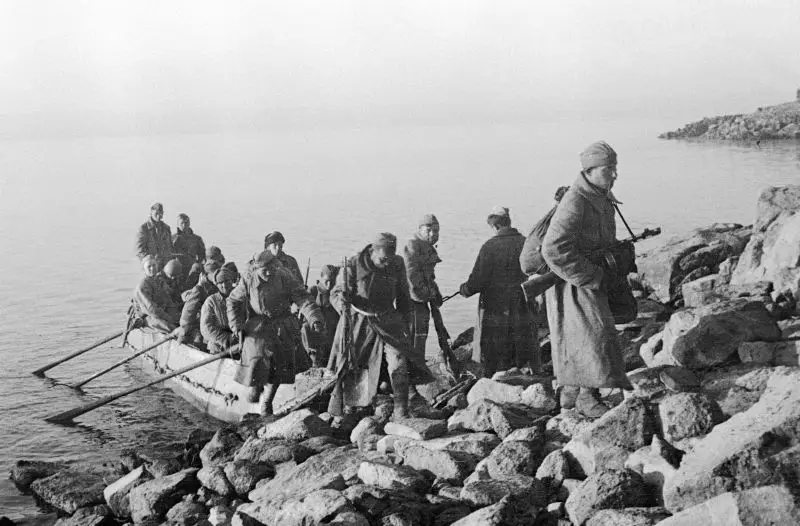
Red Army soldiers are transported to a bridgehead on the banks of the Dnieper. September 23, 1943
Development of the offensive and liberation of Kyiv
The battle for the Dnieper is entering a new stage.
Soviet troops are faced with the task of liberating the ancient Russian capital and the capital of the Ukrainian SSR - Kyiv, eliminating the enemy's left-bank bridgeheads and expanding their right-bank bridgeheads. The German command is trying to destroy Soviet bridgeheads and restore the defense line along the Dnieper.
On October 9, 1943, the SF troops resumed the offensive, overcame the enemy’s defense line on the Molochnaya River and began a battle for Melitopol, which covered the approaches to the Crimea and the lower reaches of the Dnieper. On October 23, Melitopol was liberated (The assault on “little Stalingrad” and the creation of the Sivash bridgehead). On October 14, troops of the Southwestern Front occupied Zaporozhye, eliminating the enemy’s bridgehead on the Left Bank (Assault on the Zaporozhye bridgehead).
On October 25, troops of the 3rd Ukrainian Front (formerly SWF) liberated Dnepropetrovsk and Dneprodzerzhinsk. In front of the 4th Ukrainian Front (formerly the Southern Front), the Germans, in order to avoid being surrounded, began to retreat to the west. On October 30, Soviet troops occupied Genichesk and Askania Nova, and the next day they began a battle for Kakhovka and Armyansk on the Turkish Wall. A bridgehead has been created in Crimea - our troops crossed Sivash. The German 17th Army in Crimea lost ground contact with the main forces of the South group.
However, it was not possible to immediately break into Crimea and liberate it. In early November, troops of the North Caucasus Front, with the support of the Black Sea fleet and the Azov flotilla landed troops and captured a bridgehead in the Kerch region (Fire land. The fierce battle for the Kerch bridgehead).
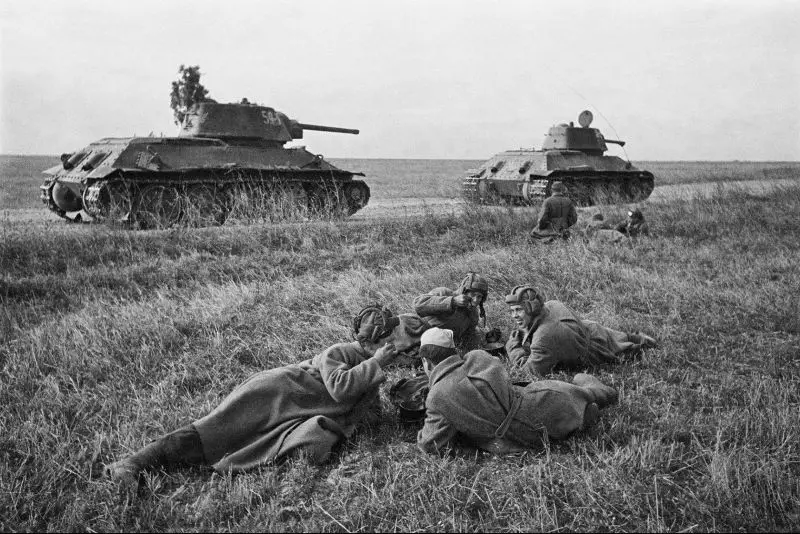
Infantry fighters and crew members of T-34 tanks of the 288th separate tank battalion of the 52nd Guards Tank Brigade of the 6th Guards Corps of the 3rd Guards Tank Army of the 1st Ukrainian Front at the last stop before the battles, near Kiev. November 3, 1943
A tough battle was going on in the Kiev direction.
The Nazis tried with all their might to destroy Soviet bridgeheads and prevent the Russians from recapturing Kyiv. The command of the 1st UV tried to liberate Kyiv and launched two strikes: from the Bukrinsky bridgehead - the main one, from the bridgehead north of Kyiv - auxiliary. However, the Germans successfully repelled the first offensive attempts of the Soviet armies.
Then the Headquarters decided to deliver the main blow from the Lyutezh bridgehead. The front forces were regrouped: the 3rd Guards Tank Army and most of the artillery were transferred to the north. They were able to hide the regrouping from the enemy (How Vatutin's armies liberated Kyiv).
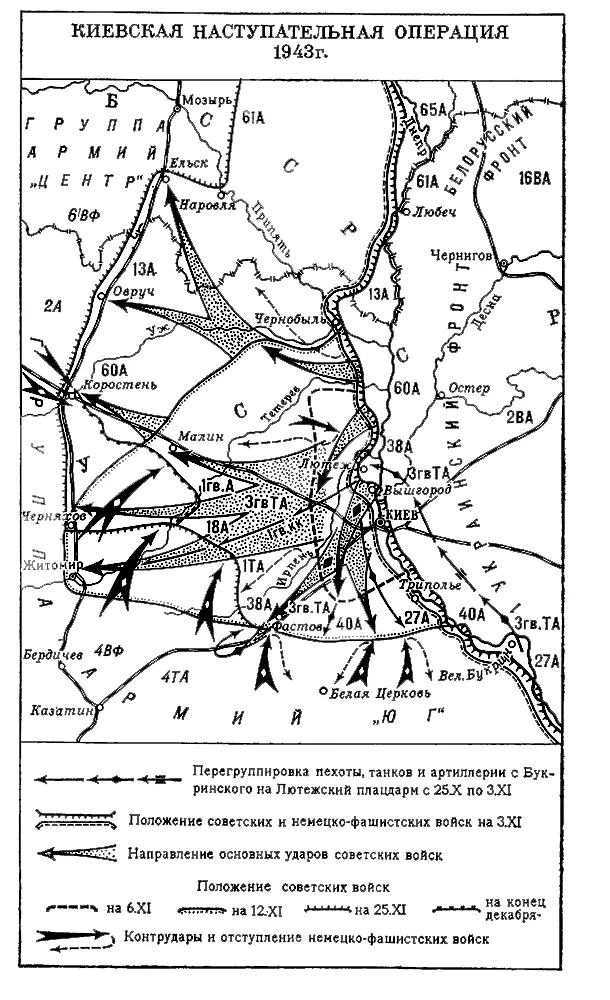
On November 3, the 60th and 38th armies of generals Chernyakhovsky and Moskalenko went on the offensive from the Lyutezh bridgehead. By the evening of November 4, the tanks of Rybalko’s army were thrown into battle. At the Bukrinsky bridgehead, our troops also attacked, attracting the attention and reserves of the enemy.
The enemy’s defenses were broken through, and by the evening of November 6, Kyiv became ours.
Developing the offensive, they recaptured Fastov on November 7, and Zhitomir on November 12. Then the troops of the left wing and the center of the 1st UV went on the defensive in order to repel the enemy counterattacks that began on November 8–15, and the troops of the right wing (13th and 60th armies) continued the offensive and by November 25 reached the Mozyr-Korosten line , Chernyakhov.
As a result, the capital of Ukraine was liberated in the Kiev direction, and a strategic bridgehead was created with a front length of 500 km and a depth of 145 km. The communications that connected Army Groups Center and South were cut.
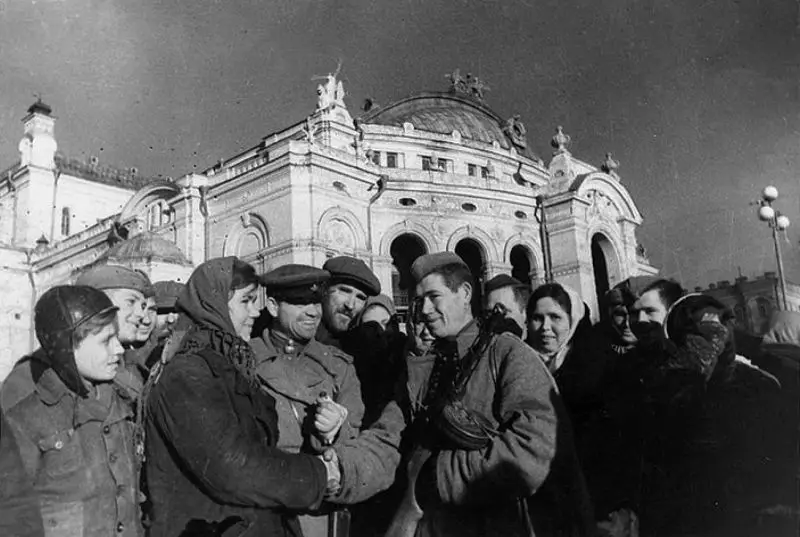
Residents of Kyiv greet the Red Army soldiers who liberated the city from the Nazi invaders on Korolenko (Vladimirskaya) Street. In the background is the building of the Academic Opera and Ballet Theater of the Ukrainian SSR named after Taras Shevchenko. November 1943
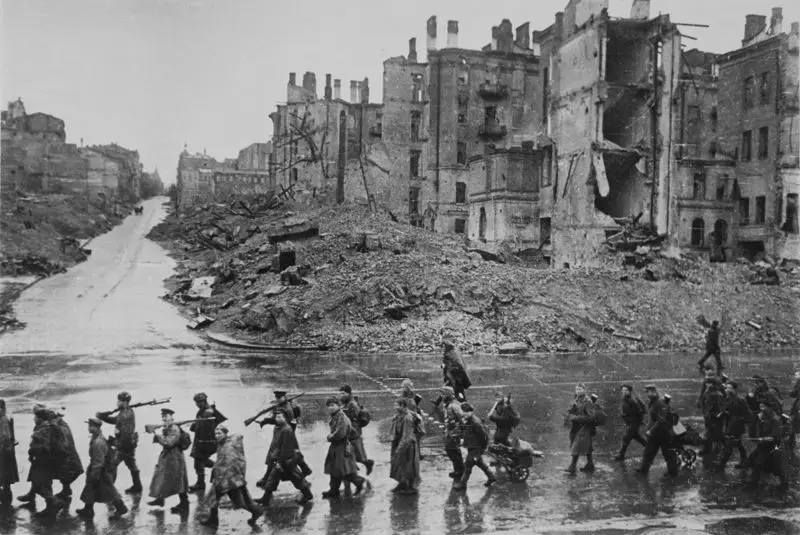
Soviet soldiers walk along Khreshchatyk in liberated Kyiv. November 7, 1943
Kyiv defensive operation
Having regrouped the forces of the 4th Tank Army and transferred reserves, the Germans prepared a counteroffensive with the goal of defeating the main forces of the 1st UV, recapturing Kyiv, throwing the Russians into the Dnieper and restoring the Dnieper line.
In the areas southwest of Fastov and south of Zhitomir, the German command concentrated two attack groups - the 48th Tank Corps, the Mattenklot task force and the 13th Army Corps. The offensive was supported by the 4th Air Fleet. On November 15–18, 1943, the German tank army rushed towards Kyiv, directing its main attack along the Zhitomir highway. The attack was carried out by 15 Wehrmacht divisions, including 7 tank and 1 motorized divisions.
German troops launched two attacks: from the Fastov area to Brusilov and from the Chernyakhov area to Radomyshl. The troops of the Soviet 38th Army, defending the front section from Zhitomir to Fastov, could not withstand the powerful blow and began to retreat in a northern direction. On November 17, German mobile units reached the Zhitomir-Kyiv highway in the Korostyshev area and launched an offensive in the Kiev direction.
On November 18, German troops, with attacks from the north, south and east, surrounded part of the forces of our 60th Army in Zhitomir. After a two-day stubborn battle, most of our troops broke the blockade and left the city. The Nazis began to hope that they would break through to the Dnieper, restore the line of defense along it and thus retain at least part of Ukraine. Meanwhile, a fierce battle broke out for Brusilov. Here the Germans attacked with 6 tank and 1 motorized divisions. Fierce fighting continued for 5 days, and on November 23, the Red Army left the city.
The enemy's hopes for a new capture of Kyiv quickly melted away. German troops were already advancing with great difficulty and suffering huge losses. Some tank divisions were completely exsanguinated, losing 50 to 70% of their manpower and most of their tanks. Replenishments did not cover losses. The shock forces of the German army were exhausted and exhausted.
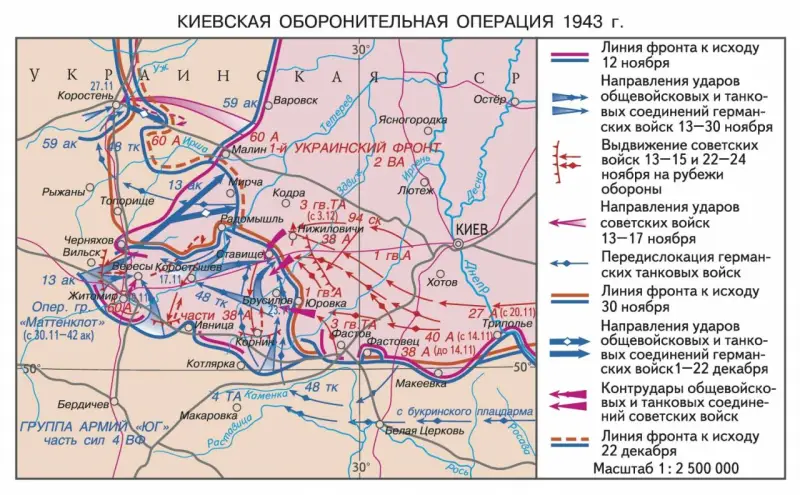
Having detained the enemy at Brusilov, the Soviet command was able to regroup its forces. Troops of the 3rd Guards Tank Army and part of the forces of the 1st Guards Army were transferred to the area north and east of Brusilov. Also, part of the forces of the 40th Army was transferred from the Bukrinsky bridgehead to the Fastov region, Tripolie, following the 27th Army. On November 26, Soviet troops launched a counterattack on the northern wing of the Brusilov group of the Wehrmacht. The German troops were drained of blood, lost their striking power, and by the end of November the front stabilized on the Chernyakhov-Radomyshl-Yurovka line.
The Soviet Headquarters gave instructions on November 28 to switch to a tough defense in order to exhaust the enemy’s forces. Simultaneously with the approach of new formations, the 1st UV was supposed to prepare an offensive with the task of defeating the enemy group in the Kiev direction.
Rifle units were replenished and created the necessary supplies of ammunition, fuel and food. The reserves of the Soviet front concentrated the forces of the 18th Army, the 1st Tank and 3rd Guards Tank Armies, two tank and one cavalry corps.
On December 6, 1943, the Germans again tried to break through to Kyiv in the sector of the 60th Army of Chernyakhovsky and the 1st Guards Army of Kuznetsov. The blow was delivered in the direction of Malin. On December 9–10, the Germans attacked in the area of Korosten and Yelsk, where Pukhov’s 13th Army was defending. The fighting was stubborn, but this time without much success for the Wehrmacht.
The Kyiv defensive operation ended on December 23.
Thus, almost a month and a half of fierce fighting in the Kiev direction did not lead to the collapse of the Soviet defense and the destruction of the Kyiv strategic bridgehead. The Wehrmacht was able to advance 35–40 kilometers; its strike forces suffered serious losses in manpower and equipment. The Germans were unable to restore the “Eastern Wall” along the Dnieper.
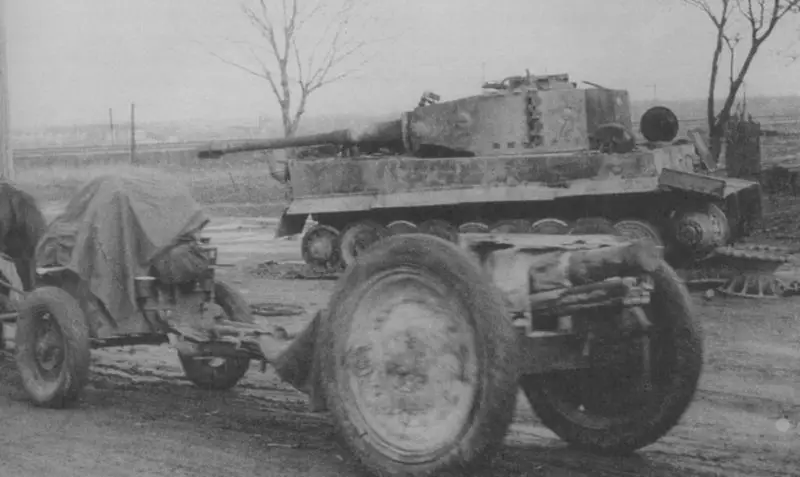
A horse-drawn Soviet regimental gun of the 1927 model drives past a damaged Pz heavy tank. Kpfw. VI Ausf. H "Tiger" in the Kyiv area. November 1943
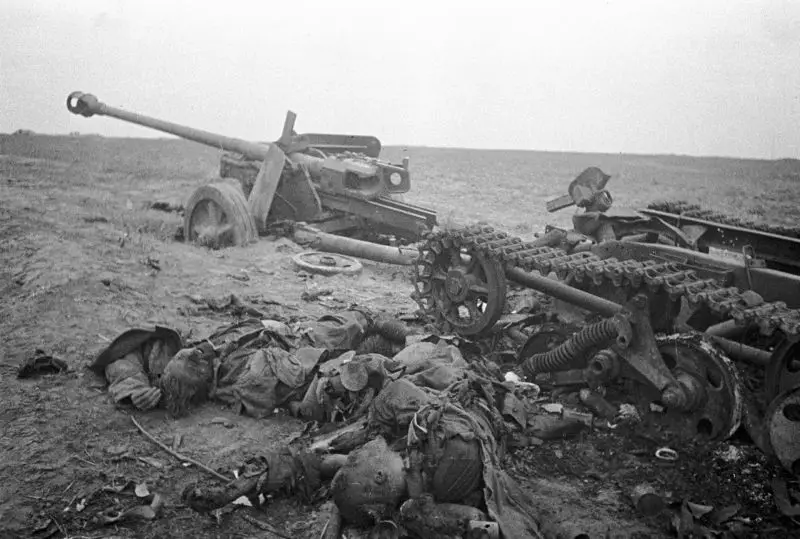
The bodies of dead German soldiers near the broken 75-mm PaK 40 (7,5-cm-PaK 40) anti-tank gun and the chassis of the Sd tractor. Kfz. 3 on the battlefield near Kiev. November 1943
Ending battle
In the south of Ukraine, troops of the 4th UV in early November cleared the left bank of the Dnieper in the Kakhovka region from the enemy and liberated this settlement. The crossing of the Dnieper began. Troops of the 3rd Guards and 5th Shock Army fought to eliminate the enemy's bridgehead in the Nikopol area.
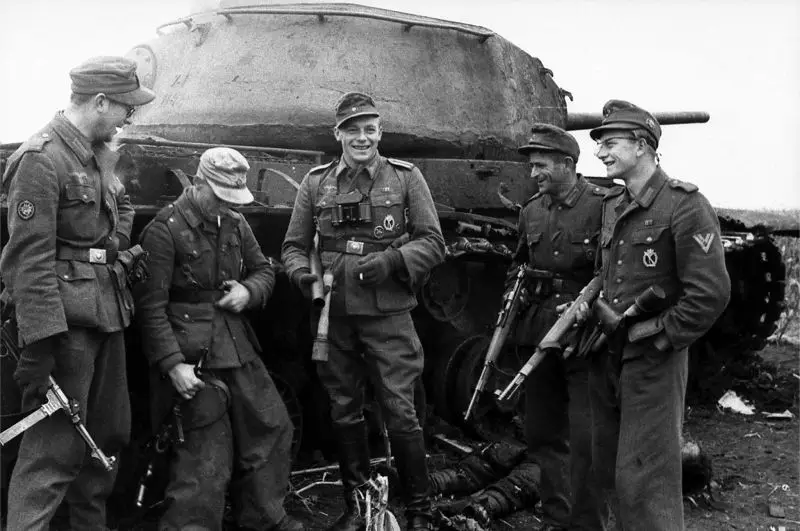
German soldiers near a damaged Soviet KV-85 tank during the battles near Nikopol. November-December 1943
On November 6, the Germans counterattacked from the Nikopol bridgehead and from the Crimea, trying to restore a land corridor with the peninsula. However, the German attacks were repelled.
Thus, the Red Army solved its main problems during the titanic battle for the Dnieper. Our troops advanced 200–400 km westward and defeated large forces of the German Army Group South. Russian troops liberated the Left Bank, reached the approaches to the Crimea and the Dnieper, and immediately crossed the Dnieper line. They liberated Kyiv and created the preconditions for the liberation of the entire Right Bank and Crimea.
The Battle of the Dnieper is a lesson for our modern military-political leadership. The “Give Kyiv in three days” plan has long been a failure. A campaign cannot be won by positional struggle. The West will continue to deplete the Russian world (military potential, economy and demography), including the Left Bank and the Right Bank.
The only way out is military, economic and social mobilization. Creation of 3-4 Ukrainian fronts, with a 2-3 times superiority in manpower, with powerful artillery and air support, and armored formations for operating in operational depth. With the second and third echelon in the form of Internal Troops divisions, FSB units, military counterintelligence (Smersh), border guards and the Ministry of Internal Affairs, who will clean up the rear.
The solution to the personnel issue in the Armed Forces is the replacement of “parquet” peacetime generals with combat officers. Liberation of all New and Lesser Russia with Kharkov, Kiev and Odessa. With the total denazification of the Ukrainian Reich, following the example of our ancestors.
Restoring the Russianness of our historical lands - Russian language, history and culture.
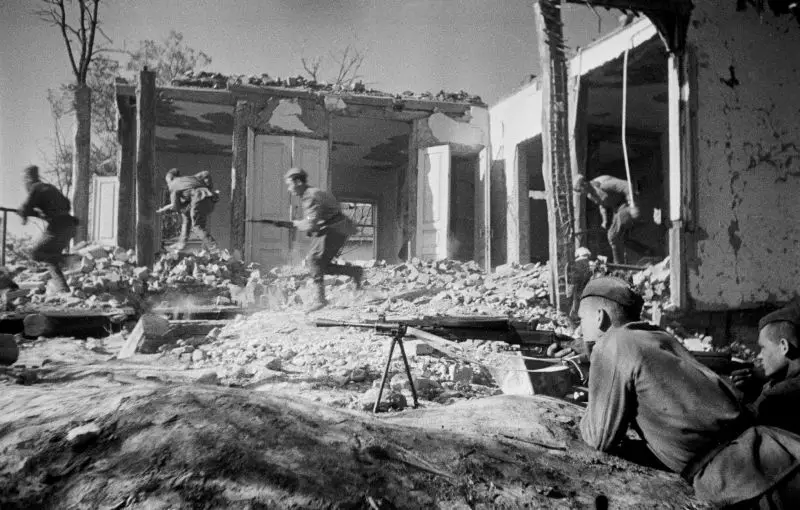
Soviet soldiers in battle in a destroyed village near Kyiv. In the foreground, a fighter fires from a DP-27 light machine gun.
Information